Six
SANTA MARIA

Santa Maria Drag Strip was the third legal drag strip in the country and hosted all the early greats of drag racing, as well as car clubs from all over California. Started in 1953 by Santa Maria Dragons member and local businessman Jerry Gaskill, it lasted until the mid-1960s and became a second home to many a hot-rodder. The center of all the action was the control tower, seen here on a busy race day. Jerry Gaskill is probably up in the tower directing the action as various track officials mill around in the foreground. The timing lights can be seen at lower right. This image was taken in the early 1960s, judging from the ambulance visible in the background. (Courtesy of Mark Mendenhall.)
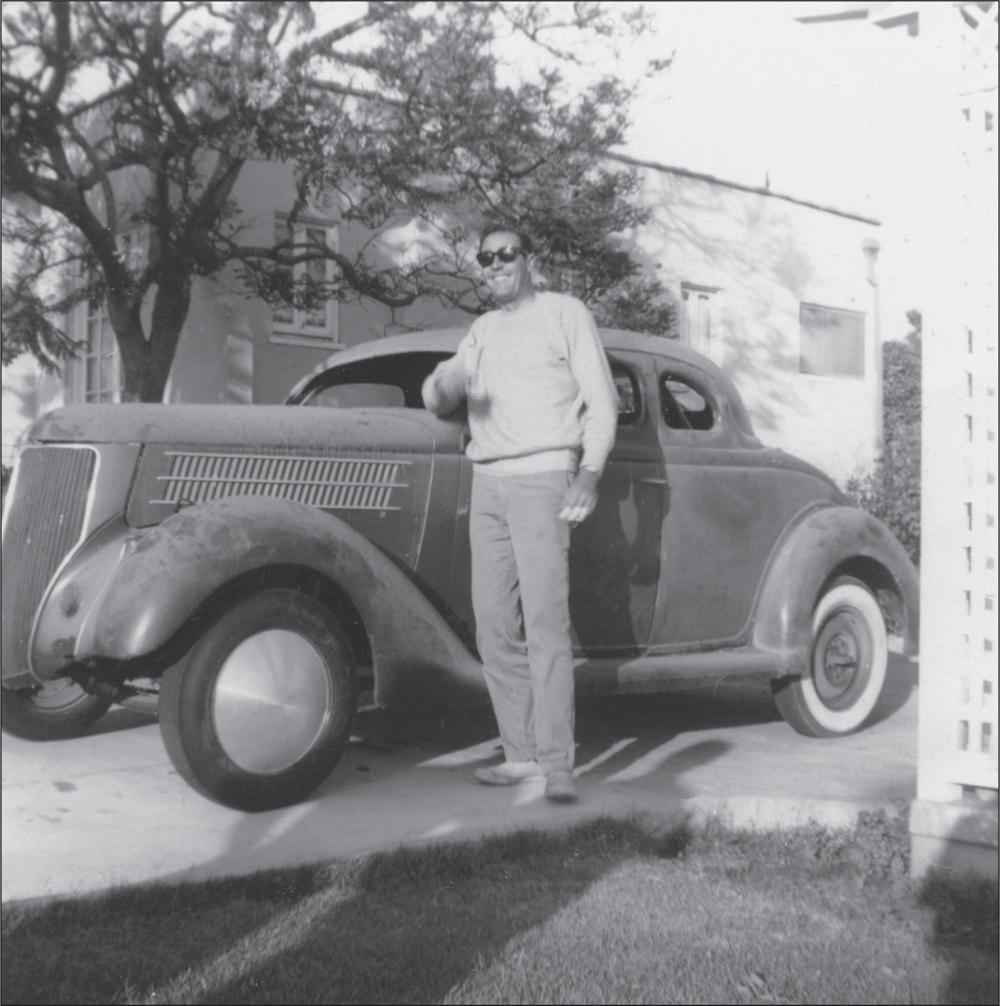
Jerry Gaskill was a native of San Luis Obispo. Shortly after graduating from San Luis Obispo High School in 1949, he acquired a Richfield service station and ran it until 1951, when he partnered with Jack Hathaway in an auto-parts store. Always an avid hot-rodder, Jerry was a regular competitor at Goleta until the strip stopped operating in 1951. With nowhere to race locally, and facing a long drive to the nearest strip in Santa Ana, Jerry looked for alternative locations to race. Settling first on Santa Maria, and later, San Luis Obispo, Jerry would run both strips successfully and also field his own dragster, occasionally taking on visiting celebrities like Tony Nancy. Gaskill eventually left the world of drag racing to become a sales representative for the Monroe Shock Absorber Company, covering California and Hawaii until his retirement. (Courtesy of Jerry Gaskill.)

This is the view Jerry had from the tower. A roadster has just left the starting line, and flagman Don Doeckle can be seen stepping forward after doing his job. The tower is facing north, looking out across what is now Foster Road toward the airport runway, one mile distant beyond the trees. The bleachers at right are gone, but the area is basically unchanged. (Courtesy of Mark Mendenhall.)

It seems like this five-window coupe may have spun out at the starting line during a qualifying run. Santa Maria Drag Strip flagman Don Doeckle may be deciding to get out of the way. Note the vintage ambulance at left. It is interesting to see that the drag strip used both starting lights and a flagman, as captured in this shot from around 1954. (Courtesy of Mark Mendenhall.)
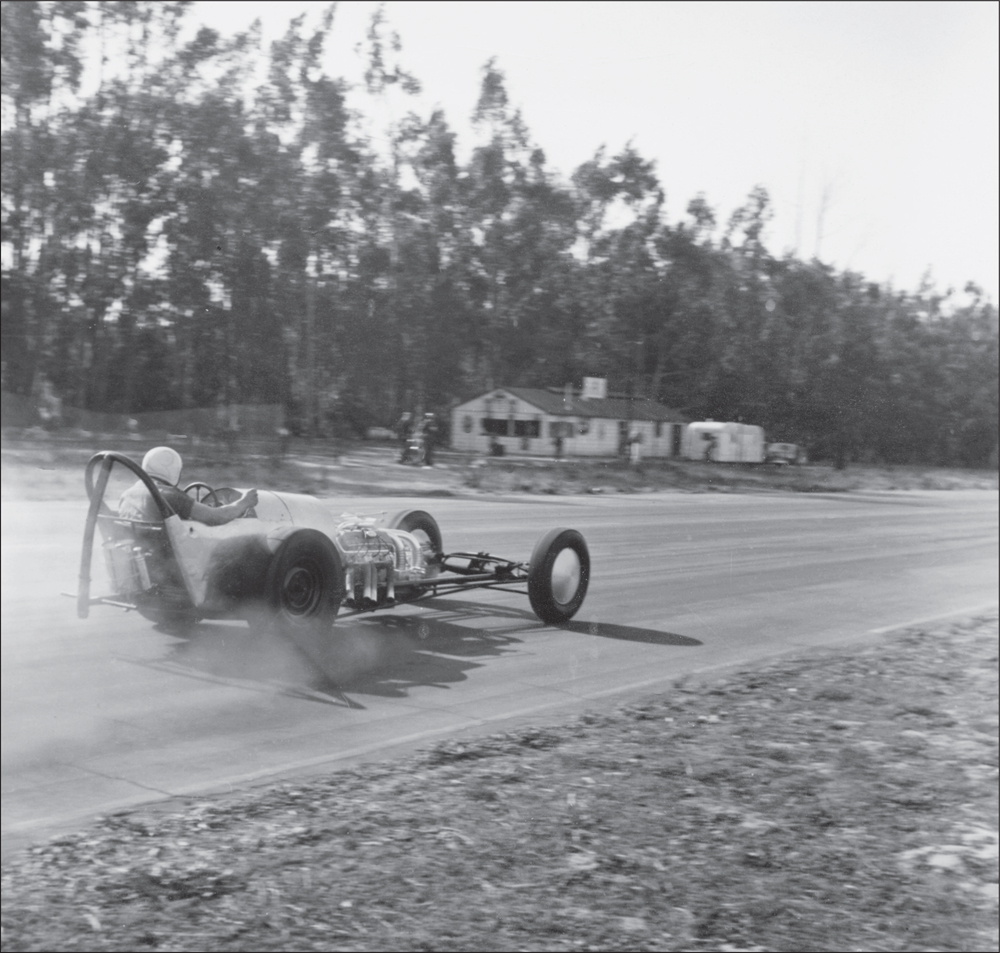
In this shot from the late 1950s, a dragster takes off down the quarter-mile track. In the background are the eucalyptus trees that make images of Santa Maria so easily identifiable. The building visible in the center background is the combination snack bar and Dragons clubhouse. In the days when the drag strip was part of an air base, the clubhouse served as a squadron dayroom. (Courtesy of Mark Mendenhall.)
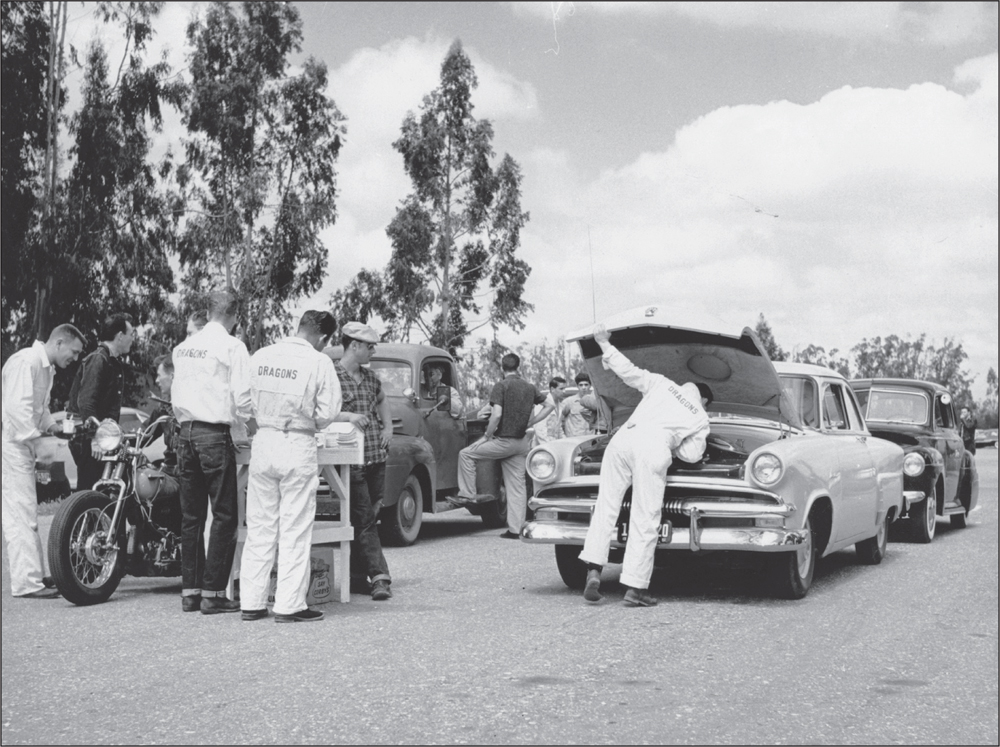
In the California tradition of “run what ya brung,” almost any type of vehicle could be seen on an average race day at Santa Maria. Visible in this shot of the safety-inspection line are a Harley-Davidson (far left), a 1941 Ford pickup that was probably used for towing, a 1956 Ford, and behind that, a hoodless 1941 Chevrolet. (Courtesy of Mark Mendenhall.)
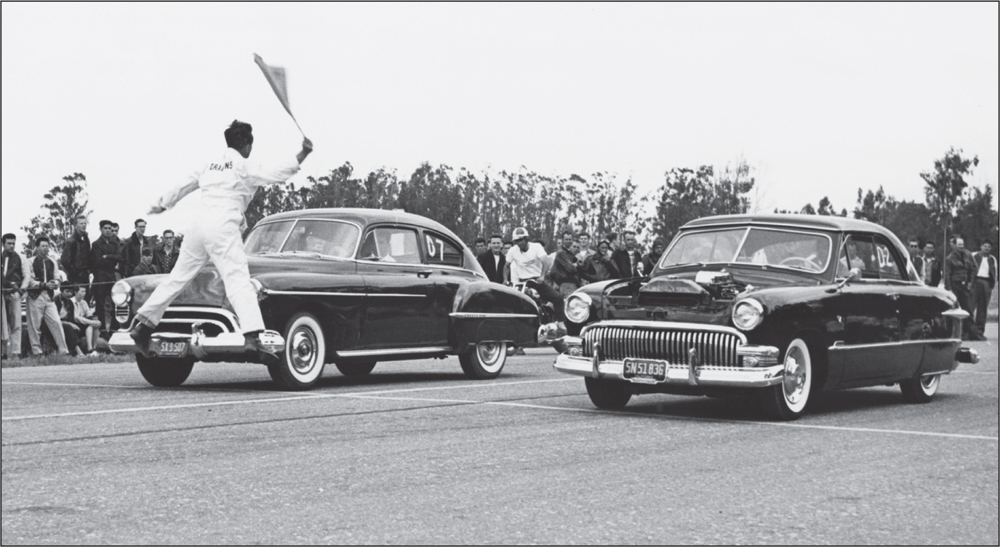
Two-door sedans duel as the flagman becomes airborne during the start of a race at Santa Maria in the late 1950s. At left is a stock-appearing 1949 Oldsmobile 98, while at right is a pretty wild-looking custom shoebox Ford with a 1947 Buick grill. (Courtesy of Mark Mendenhall.)

Twin-engined dragsters were crowd-pleasing attractions at races of the late 1950s and early 1960s and were run by such notables as Art Arfuns, Tony Nancy, and Tommy Ivo. Central Coast local Fred Dannenfelzer built this one, seen here on a cold day at Santa Maria, using a pair of blown Chrysler Hemi engines. (Courtesy of Fred Dannenfelzer.)
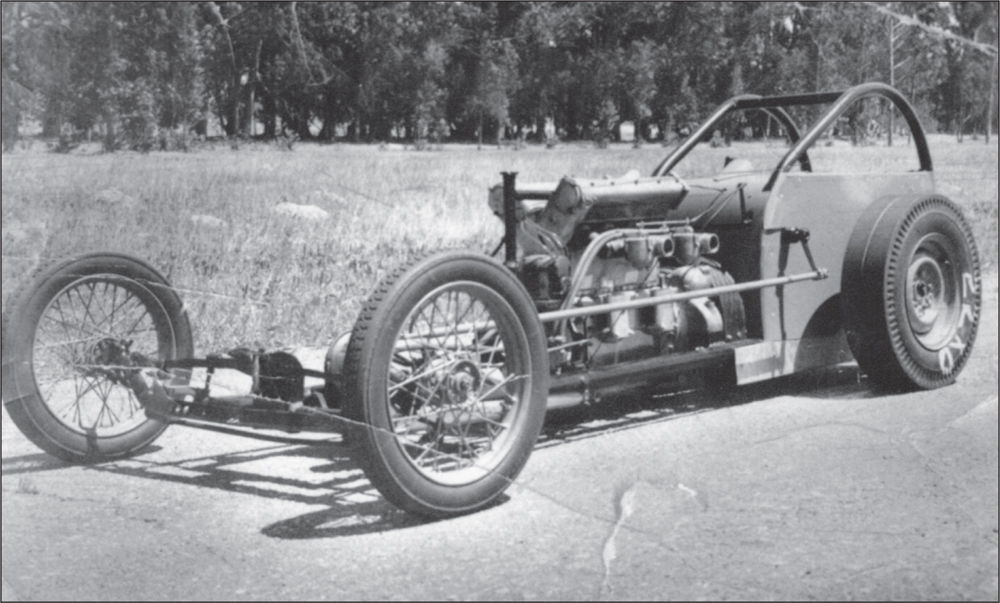
Veteran hot rod builder Jack Larimore of Ventura built this unusual Miller-powered dragster, which set a track record for four-cylinder–powered cars on October 2, 1960, when it reached 108.43 miles per hour on the quarter mile. The Miller Company produced highly tuned, custom-made racing engines, similar to Offenhausers, which were used mostly in Indianapolis racers and sprint cars. (Courtesy of Ambrose Little.)
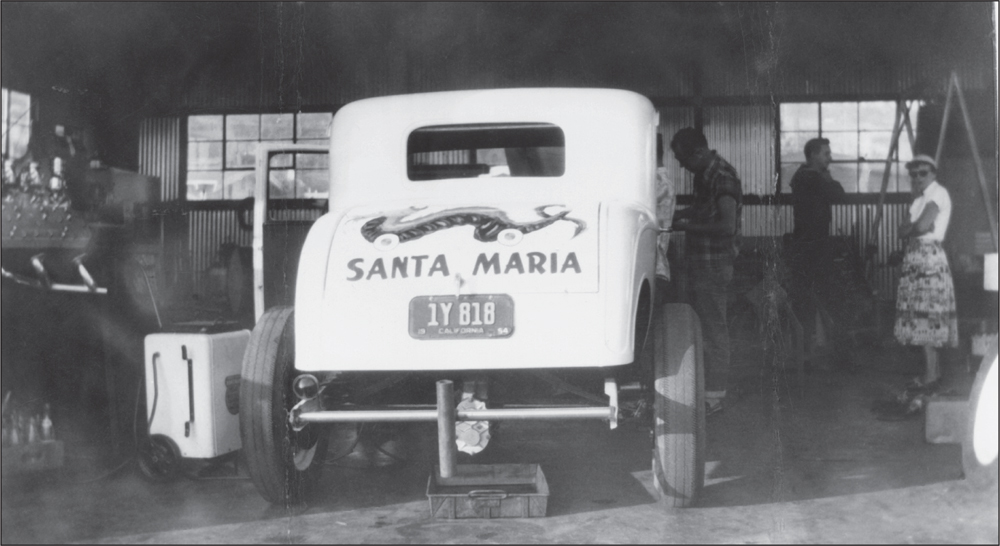
This 1932 five-window coupe belonged to Dale Latham and is shown being prepared for a trip to Bonneville in 1954, where it would attain 170 miles per hour. The location is Bob Joehnck’s Garage on Chapala Street in Santa Barbara. Note the flathead on a stand at far left and the rather bored-looking young lady at far right. (Courtesy of Jerry Gaskill.)
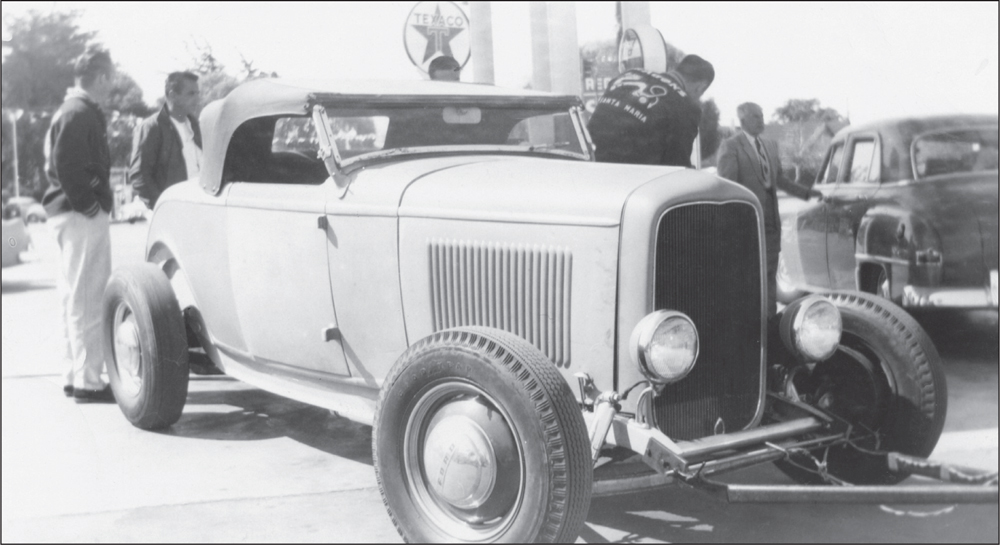
This is Gaskill’s first hot rod, a 1932 Deuce roadster that he bought at age 14 and kept for many years. It is shown here on a trip with the Dragons to Salinas Drag Strip. The Dragons’ bright red club coats were the football type, and on the back was the club logo, featuring a green-and-yellow dragon on wheels. (Courtesy of Jerry Gaskill.)

Famous customizer George Barris built these two street rods for Santa Maria local Jim Seaton. Seaton approached Jerry Gaskill, wanting a pair of customs, and Gaskill went to Barris for this result. The two cars drew large crowds when they appeared at local meets. Both Chevrolets—one a 1955 two-door sedan and the other a 1959 El Camino—were painted in matching white pearl with metallic copper trim schemes. (Courtesy of Jerry Gaskill.)
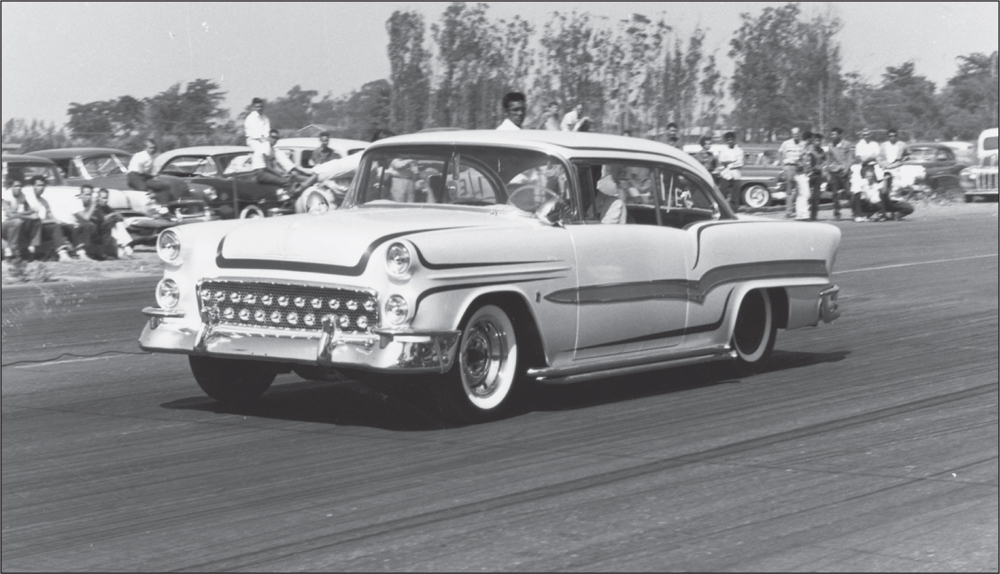
Carrying on the matching theme, the cars have each been equipped with lake pipes, twin spotlights, and the same grill treatment. The chrome “bullets” on the grill screens were fashioned from off-the-shelf kitchen doorknobs. The sedan still exists in a Midwestern collection, but the El Camino has become lost to time. (Courtesy of Jerry Gaskill.)

Tony Cochiolo (left), of the Santa Maria Dragons, and Jerry Williams, of the Ventura Kustomeers—co-owners of this DeSoto-powered 1931 Ford coupe—are seen preparing for a race at San Luis Obispo in 1959. They also ran this car at Bonneville Salt Flats. It was painted in a bright red-orange color known back then as “competition orange.” (Courtesy of Jerry Williams.)

A legendary event in Central Coast drag-racing folklore was the day Ron Williams raced Dave Marquez in 1954. The friendly rivals, both from Ventura County, were just leaving the line after the flag dropped when the engine in Marquez’s No. 880 cut out. Williams, in No. 159, was halfway down the track by the time he noticed Marquez’s problem. Although technically the winner, Williams pulled his drag racer around in a U-turn and returned to the starting line in a display of good sportsmanship. The race was restaged, with Williams finishing as the winner. (Courtesy of Jerry Williams.)

Pioneer hot-rodder Ron Williams of Ventura is seen here at Santa Maria in his maroon 1929 Model A roadster. Ron, a member of the Whistlers car club, was famous for a record-setting run at Bonneville in this car. Standing to Ron’s right in the checked flannel shirt is another notable hot-rodder, Jim Harris, a member of the Kustomeers and later the Motor Monarchs. (Courtesy of Jerry Williams.)
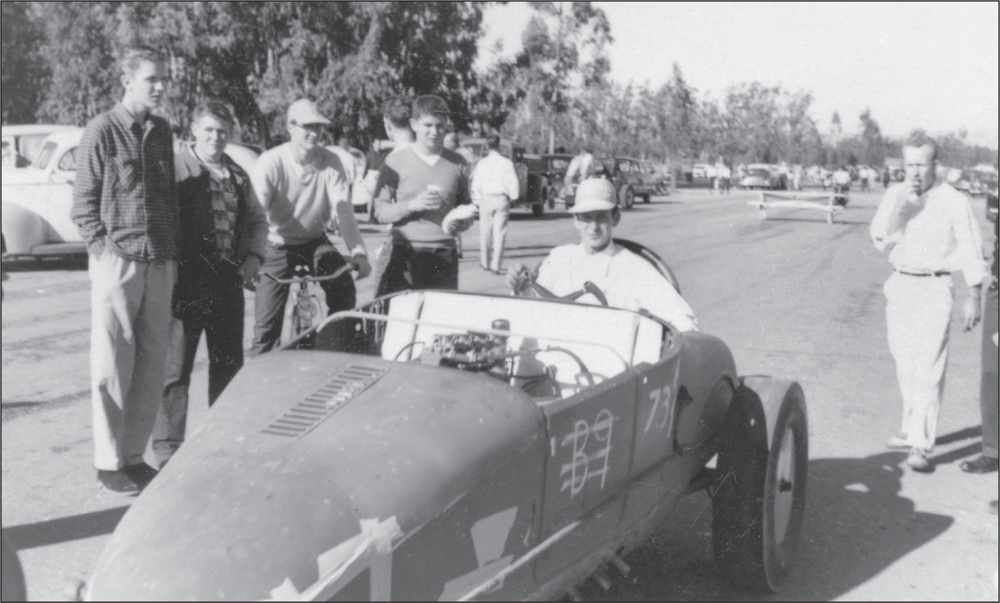
Dave Marquez of Santa Paula was National Hot Rod Association Class B top eliminator in 1955 as well as a member of the famous Motor Monarchs of Ventura. He is pictured in the Monarchs’ club car, the 440 Junior. The little Model T–based dragster would soon be rebuilt by Howard Clarkson of the Motor Monarchs, who would become top eliminator in it in the 1956 Nationals. (Courtesy of Howard Clarkson.)

Looking cool as he leans against Tom Swiggins’s 1932 Victoria is Greg Carlson of the Grave Gamblers car club. Swiggins raced the yellow Ford for the Grave Gamblers and powered it with a blown flathead, as seen here at Santa Maria. Note the 16-ounce Budweiser beer cans used as intake stacks for the triple Stromberg carburetor setup. (Courtesy of Jack Chard.)

In this shot, some of the Dusters await their turns at the Santa Maria starting line while parked next to an ambulance. Jack Chard sits in the cockpit of his black dragster, and behind him is his friend and fellow Duster Bruce McGee. Although McGee is racing the Cadillac as a stocker, the car actually belongs to Chard. (Courtesy of Jack Chard.)

Jerry Gaskill also ran a strip 25 miles to the north in San Luis Obispo in conjunction with his operation at Santa Maria, forming the San Luis Obispo County Timing Association in 1955. Racing was done on the main runway of San Luis Obispo Airport. The flagman at San Luis Obispo was local law enforcement officer Bill Malman. Jack Mendenhall’s 1932 coupe is at left. (Courtesy of Mark Mendenhall.)

This formidable lineup of drag racers was taken at Jerry Gaskill’s San Luis Obispo drag strip. From left to right are an early “rail” dragster, Jay Roach’s 1931 Model A sedan, a chopped Model A Tudor, a 1929 roadster with a Deuce grill shell, and a radically chopped 1934 Ford Coupe. Note that each is equipped with a blower. (Courtesy of Hunter Self and Betty Roach.)
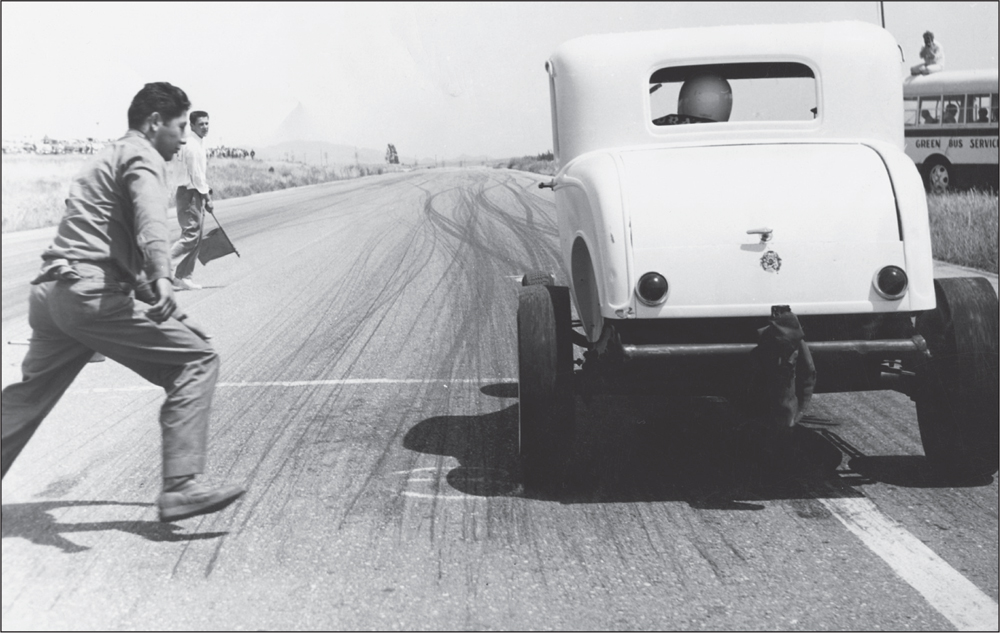
In this action shot, pit crew chief Marshall Solis rushes out to give Jack Mendenhall some last-minute instructions as Don Doeckle prepares to start the race at San Luis Obispo. Mendenhall, a member of the Bonneville 200 MPH Club, would later take this coupe up to 151 miles per hour on the salt flats. (Courtesy of Mark Mendenhall.)
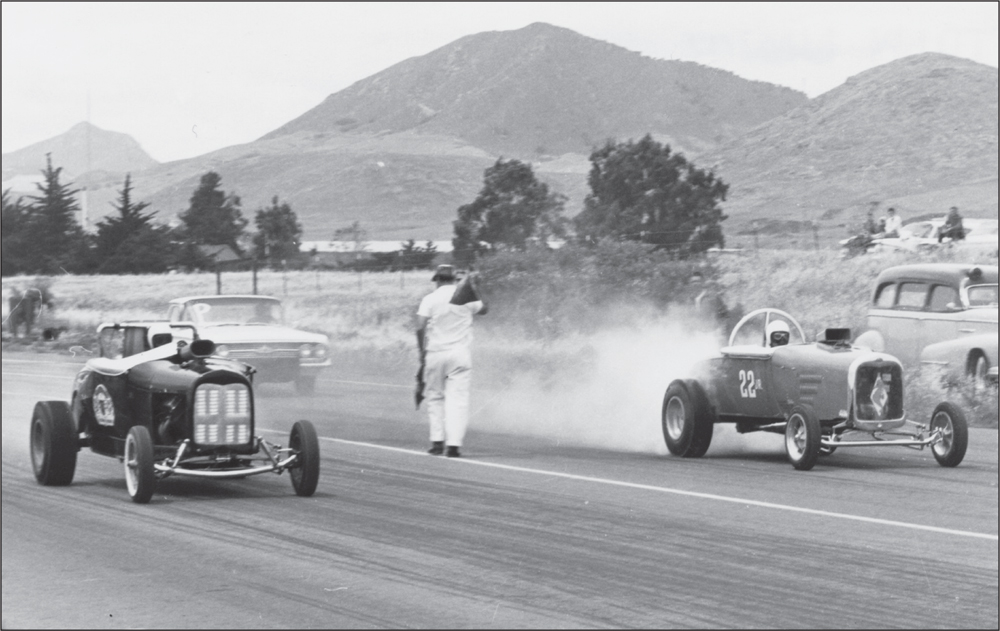
Two blown 1929 roadsters leave the starting line at San Luis Obispo in this image. At left is strip owner Jerry Gaskill, and at right is famous drag racer Tony Nancy. Gaskill’s dragster was powered by Oldsmobile, while Nancy had a Buick Nailhead in his. At far right is the 1942 Buick ambulance that Gaskill kept on-site when the strips were operating. (Courtesy of Jerry Gaskill.)
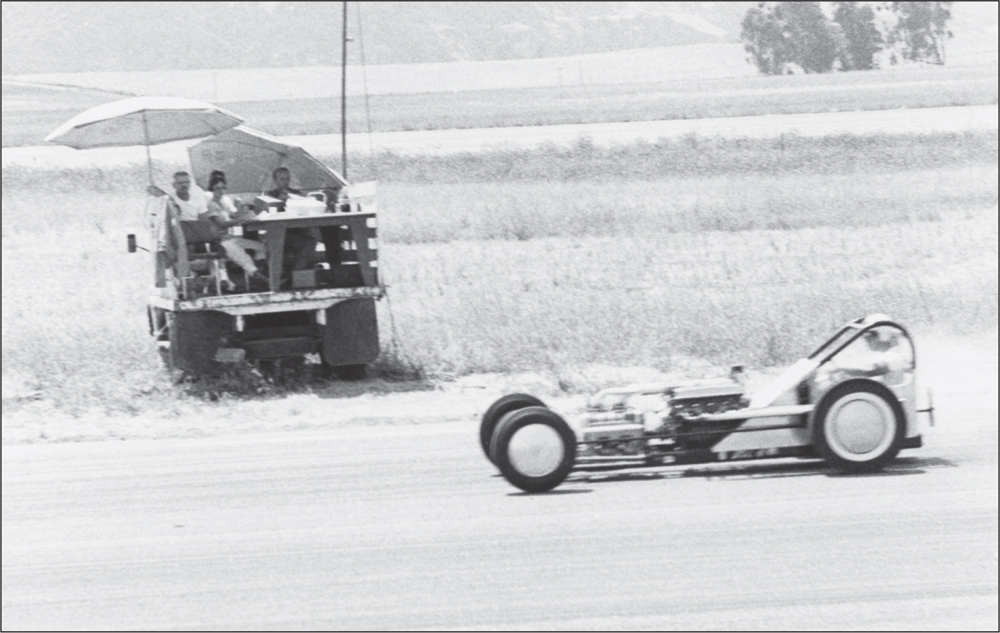
Since races at San Luis Obispo were actually held on an active runway for aircraft, there could be no permanent drag strip structures like bleachers or a timing tower. When an airplane did approach, a flag was waved, and everyone got out of the way. Minutes after this image was taken, the pole holding the PA system cable at right collapsed on the truck bed serving as the timing tower and struck Jerry Gaskill on the head, knocking him out. (Courtesy of Jerry Gaskill.)

Jack and Jerry’s Auto Supply, located at 565 Higuera Street in San Luis Obispo was owned by Jerry Gaskill and his partner Jack Hathaway, who is pictured behind the counter. The business, in operation from 1952 to 1961, was a well-known speed shop and was highly visible in the local hot rod community, competing at drag races with its own 1929 roadster. (Courtesy of Jerry Gaskill.)

This is an interesting view from the other side of the counter. Various automotive products are on display in the windows, and an assortment of spinner hubcaps adorns the walls. Outside on Higuera Street, a channeled Ford Tudor sits on a trailer waiting to be towed to one of the local tracks as someone works on the engine. (Courtesy of Jerry Gaskill.)
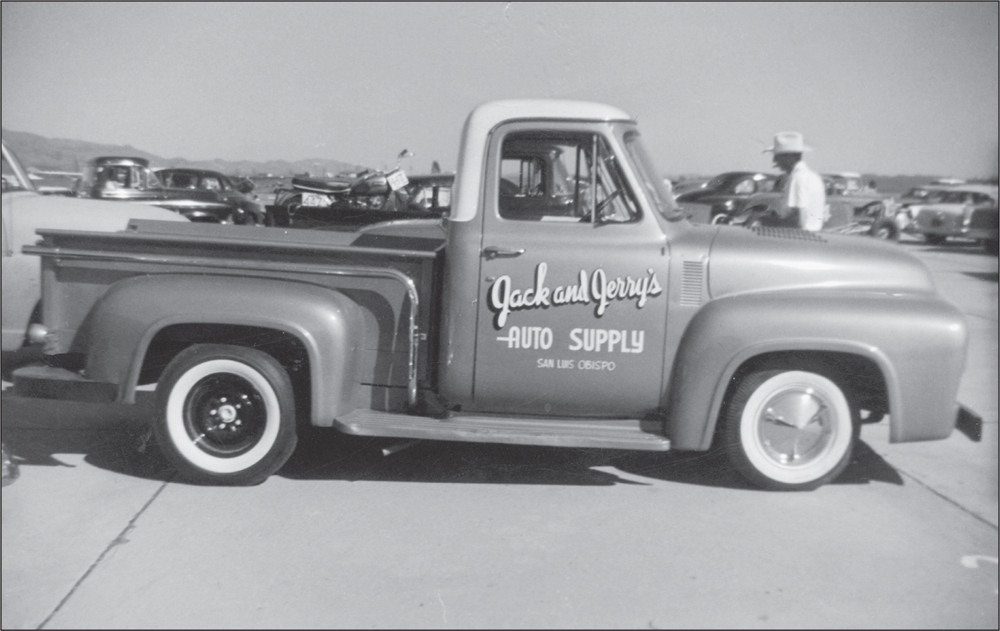
Jack and Jerry’s used this 1954 Ford pickup as a tow/push truck. Painted in the store colors of purple and white, the truck was good for advertising the business, too. The long, chrome exhaust pipe seen passing over the rear fender along the pickup bed was an aftermarket lake pipe extension for trucks sold by the store. (Courtesy of Jerry Gaskill.)

Hot rod club activity continued on the Central Coast into the late 1960s as evidenced by this image of the Santa Barbara Oldies But Goodies car club taken at the 1968 Roadster Roundup in Pismo Beach, California. The group pictured here is in Lee Hammock’s 1929 Ford Model A pickup, parked off of Pomeroy Street. (Courtesy of Lee Hammock.)
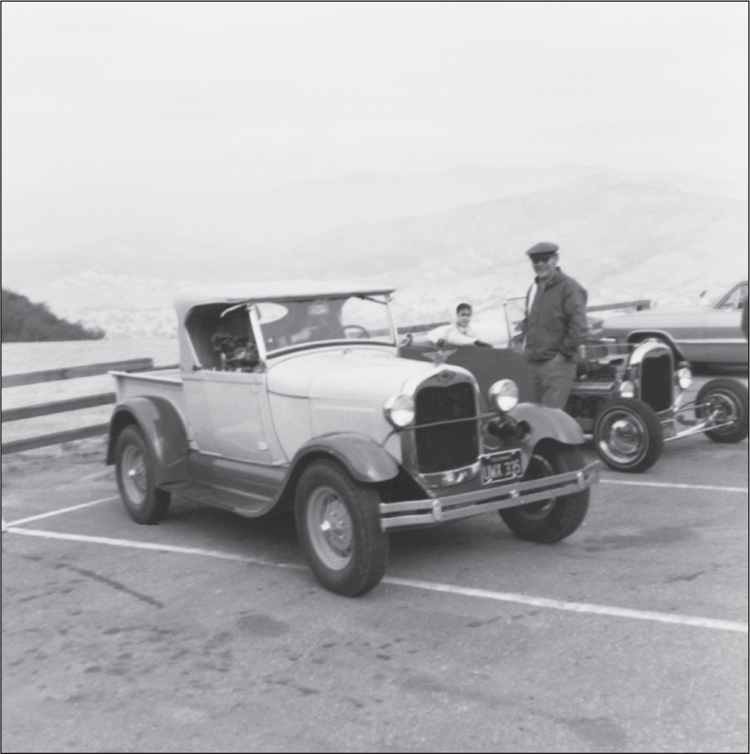
Here is another shot of Lee Hammock’s roadster pickup, seen at a highway rest stop somewhere on the Central Coast. Parked behind him is a 1929 Ford Model A roadster hot rod belonging to Jack Chard. (Courtesy of Lee Hammock.)




























